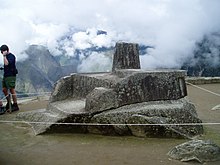World Wonders: Machu Picchu
Machu Picchu
Machu Picchu is a 15th-century Inca citadel situated near Huayna Picchu mountain ridge. Machu Picchu stands 2,430 meters above sea-level, in the middle of a tropical mountain forest, in an extraordinarily beautiful setting. It was probably the most amazing urban creation of the Inca Empire at its height; its giant walls, terraces, and ramps seem as if they have been cut naturally in the continuous rock escarpments. The natural setting, on the eastern slopes of the Andes, encompasses the upper Amazon basin with its rich diversity of flora and fauna. It is located in the Cusco Region, Urubamba Province, Machupicchu District in Peru, above the Sacred Valley, which is 80 kilometers (50 mi) northwest of Cuzco and through which the Urubamba River flows. In the Quechua language, machu means "old" or "old person", while pikchu means "peak; mountain or prominence with a broad base that ends in sharp peaks", hence the name of the site means "old peak".
Panoramic view of Machu Picchu with Huayna Picchu at the background.
History
Machu Picchu was built around 1450, at the height of the Inca. Its construction appears to date to the period of the two great Inca rulers, Pachacutec Inca Yupanqui (1438–71) and Túpac Inca Yupanqui (1472–93). It was abandoned just over 100 years later, in 1572, as a belated result of the Spanish Conquest. It is possible that most of its inhabitants died from smallpox introduced by travelers before the Spanish conquistadors arrived in the area. Although it was located only about 80 kilometers (50 mi) from the Inca capital in Cusco, the Spanish never found Machu Picchu and so did not plunder or destroy it, as they did many other sites. Although known locally, it was not known to the Spanish during the colonial period and remained unknown to the outside world until American historian Hiram Bingham brought it to international attention in 1911.
Machu Picchu was declared a Peruvian Historical Sanctuary in 1981 and a UNESCO World Heritage Site in 1983. In 2007, Machu Picchu was voted one of the New Seven Wonders of the World in a worldwide Internet poll.
The Sites
The site is roughly divided into an urban sector and an agricultural sector, and into an upper town and a lower town. The temples are in the upper town, the warehouses in the lower.
The architecture is adapted to the mountains. Approximately 200 buildings are arranged on wide parallel terraces around an east-west central square. The various compounds, called kanchas, are long and narrow in order to exploit the terrain. Sophisticated channeling systems provided irrigation for the fields. Stone stairways set in the walls allowed access to the different levels across the site. The eastern section of the city was probably residential. The western, separated by the square, was for religious and ceremonial purposes. This section contains the Torreón, the massive tower which may have been used as an observatory.
Located in the first zone are the primary archaeological treasures: the Intihuatana, the Temple of the Sun and the Room of the Three Windows. These were dedicated to Inti, their sun god, and greatest deity. The Popular District, or Residential District, is the place where the lower-class people lived. It includes storage buildings and simple houses.
The royalty area, a sector for the nobility, is a group of houses located in rows over a slope; the residence of the amautas (wise persons) was characterized by its reddish walls, and the zone of the ñustas (princesses) had trapezoid-shaped rooms. The Monumental Mausoleum is a carved statue with a vaulted interior and carved drawings. It was used for rites or sacrifices. The Guardhouse is a three-sided building, with one of its long sides opening onto the Terrace of the Ceremonial Rock. The three-sided style of Inca architecture is known as the wayrona style.

Temple of the Sun or Torreon

Intihuatana, a notable ritual stone associated with the astronomic clock or calendar of the Inca.

Interior of an Inca building, featuring trapezoidal windows.
Source:
https://en.wikipedia.org/wiki/Machu_Picchu
https://en.wikipedia.org/wiki/Huayna_Picchu
https://en.wikipedia.org/wiki/Intihuatana
http://whc.unesco.org/en/list/274
Source:
https://en.wikipedia.org/wiki/Machu_Picchu
https://en.wikipedia.org/wiki/Huayna_Picchu
https://en.wikipedia.org/wiki/Intihuatana
http://whc.unesco.org/en/list/274

Komentar
Posting Komentar